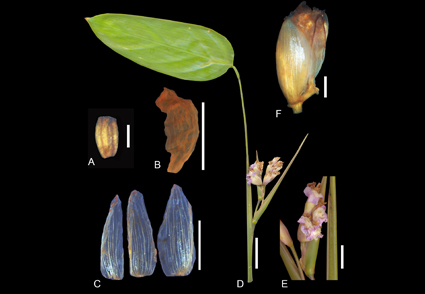Abstract
We describe two new species of Marantaceae of the Brazilian Atlantic Forest. These species were discovered in northern Espírito Santo state, inside Reserva Natural Vale. Ctenanthe brevibractea is here compared to C. lanceolata, and can be distinguished by its overall shorter stature, glabrous leaf sheath, inflorescence rachis with shorter internodes, component bracts obovate-acuminate, deciduous, holding 1–2 cymules, per cymule with one bracteole, and flowers with solitary, spathulate outer staminodes. Saranthe rufopilosa is most similar to S. leptostachya, but differs by having 2-nodated inflorescences, and indumentum of long stiff reddish trichomes disposed on peduncles, rachis, internodes of inflorescences, cymule peduncles, pedicels, sepals and ovary. Their distribution maps and photographs are also provided.
References
- Al-Gharaibeh, H.M.M. (2017) Seed germination and genetic structure of two Salvia species in response to environmental variables among phytogeographic regions in Jordan (Part I) and Phylogeny of the pan-tropical family Marantaceae (Part II). PhD Thesis. Martin Luther University Halle-Wittenberg, Halle.
- Andersson, L. (1976) The synflorescence of the Marantaceae. Organization and descriptive terminology. Botanika Notiser 129: 39–48.
- Andersson, L. (1998) Marantaceae. In: Kubitzki, K. (Ed.) The Families and Genera of Vascular Plants. Springer Verlag, Berlin, pp. 278–293. https://doi.org/10.1007/978-3-662-03531-3_31
- Andersson, L. & Chase, M.W. (2001) Phylogeny and classification of Marantaceae. Botanical Journal of the Linnean Society 135: 275–287. https://doi.org/10.1111/j.1095-8339.2001.tb01097.x
- APG IV—Angiosperm Phylogeny Group (2016) An update of the Angiosperm Phylogeny Group classification for the orders and families of flowering plants: APG IV. Botanical Journal of the Linnean Society 181: 1–20. https://doi.org/10.1111/boj.12385
- BFG—The Brazil Flora Group (2015) Growing knowledge an overview of seed plant diversity in Brazil. Rodriguésia 66: 1085–1113. https://doi.org/10.1590/2175-7860201566411
- Brown, R. (1814) General remarks, geographical and systematical, on the botany of Terra Australis. In: Flinders, M.A (Ed.) A Voyage to Terra Australis 2: 553–613. https://doi.org/10.5962/bhl.title.50709
- Dutra, V.F., Alves-Araújo, A. & Carrijo, T.T. (2015) Angiosperm Checklist of Espírito Santo: using electronic tools to improve the knowledge of an Atlantic Forest biodiversity hotspot. Rodriguésia 66: 1145–1152. https://doi.org/10.1590/2175-7860201566414
- Eichler, A.W. (1884) Beitrage zur morphologie und systematik der Marantaceen. Abhandlungen der Königlichen Akademie der Wissenschaften zu Berlin 1883: 1–99.
- Fernandes, G.C., Luna, N.K., Fraga, E., Barros, M.C., Chase, M.W. & Pessoa, E.M. (2023) Molecular phylogenetics of Maranta (Marantaceae: Zingiberales): non-monophyly and support for a wider circumscription. Botanical Journal of the Linnean Society 202: 181–194. https://doi.org/10.1093/botlinnean/boac064
- Fraga, F.R.M. (2024a) Ctenanthe. In: Flora e Funga do Brasil. Jardim Botânico do Rio de Janeiro. Available from: https://floradobrasil.jbrj.gov.br/FB9331 (accessed 25 September 2024)
- Fraga, F.R.M. (2024b) Saranthe. In: Flora e Funga do Brasil. Jardim Botânico do Rio de Janeiro. Available from: https://floradobrasil.jbrj.gov.br/FB9371 (accessed: 25 September 2024).
- Petersen, O.G. (1890) Marantaceae. In: Martius, C.F.P., Eichler, A.W. & Urban, I. (Eds.) Flora Brasiliensis. Fleicher, Liepizig, pp. 81–172.
- POWO (2024) Plants of the World Online. Facilitated by the Royal Botanic Gardens, Kew. Published on the Internet: http://www.plantsoftheworldonline.org/ (accessed 25 September 2024)
- Prince, L.M. & Kress, W.J. (2006) Phylogenetic relationships and classification in Marantaceae: insights from plastid DNA sequence data. Taxon 55: 281–296. https://doi.org/10.2307/25065578
- Regel, E. (1857) Annotationes Botanicae. In: Kuester, L.B., Regel, E., Körnicke, F. & Rach, L. (Eds.) Index seminum quae Hortus Botanicus Imperialis Petropolitanus pro mutua commutatione offert, accedunt animadversiones botanicae nonnullae. Hortus Botanicus Imperialis Petropolitanus, Petropoli [St. Petersburg], pp. 25–59.
- Schumann, K. (1902) Marantaceae. In: Engler, H.G.A. (Ed.) Das Pflanzenreich. Vol. 4. Engelman, Leipzig, pp. 1–184.
- Thomas, W. (2008) The Atlantic Coastal Forest of Northeastern Brazil. Memoirs of the New York Botanical Garden 100: 319–350.
- Zanotti, C.A., Ospina, J.C. & Keller, H.A. (2018) Sinopsis y novedades taxonómicas de la familia Marantaceae en la Argentina, incluyendo una nueva cita para el Paraguay. Boletín de la Sociedad Argentina de Botánica 53: 469–486. https://doi.org/10.31055/1851.2372.v53.n3.21320
- Yoshida-Arns, K.N. (2003) Revisão dos gêneros Ctenanthe Eichler e Stromanthe Sond. PhD Thesis. Universidade Federal de Pernambuco, Recife.


